Each November, cultures around the world celebrate holidays to remember ancestors and loved ones who have passed away. In Mexico (and the U.S.) we know this day as Día de los Muertos (“Day of the Dead”) but in Ecuador, they call it Día de los Difuntos (literally, “Day of the Deceased”). The Day of the Dead in Ecuador coincides with the Catholic holiday of All Soul’s Day and is observed from October 31 to November 2. The holiday is inspired by Catholicism but incorporates indigenous traditions unique to each region.
Last year at about this time, we were traveling in Ecuador. I noticed signs hanging on the windows of every restaurant and cafe advertising specials on something I’d never heard of, “Guagas de pan y colada morada.”
It took me a few days (and a few hurried conversations with shopkeepers) before I pieced together that these were seasonal foods made to celebrate the day of the dead.
Colada Morada and Guaguas de Pan
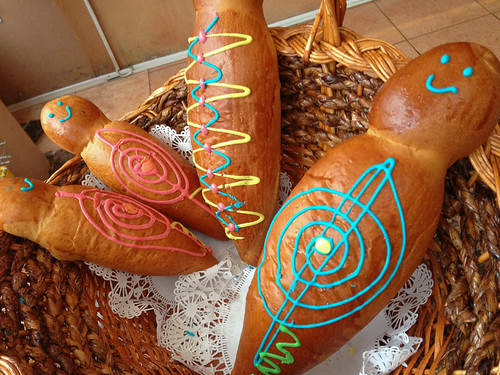
Colada morada is a thick, sweet purple corn drink cooked with mashed berries and spices and served hot. Guaguas de pan are sweet breads shaped like babies — guagua is a quechua word that means baby or child. In writing this, I learned that this quechua word is commonly mixed in with Spanish, and many Ecuadorian parents say “mis guaguas” to refer to their children. Eating these sweets is meant to give sustenance to ancestors for their travels in the afterlife.
We bought guaguas de pan and colada morada from a street vendor in Quito. It was a stressful interaction. It was the beginning of the trip and I was cautious about eating anything that may not have been made with purified water. My defenses on things like this always drop after a few days on the road in developing regions, and I rarely get sick, but we were traveling with Kevin’s dad who had had some recent health problems, so I was a little worried about his immune system. I decided to risk it, and we were all just fine.
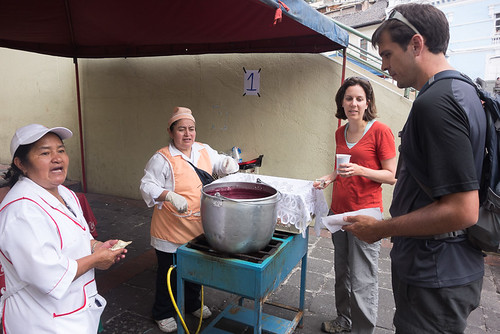
I remember asking the ladies if there was any particular way you were supposed to eat the bread and hot beverage (e.g. dip the bread in the colada? Eat the dense colada with a spoon? Not eat the guagua’s head?) They looked at me like I was crazy, and I realized I was over thinking the tradition and we just ate it as we strolled. I still felt weird eating the baby’s head.
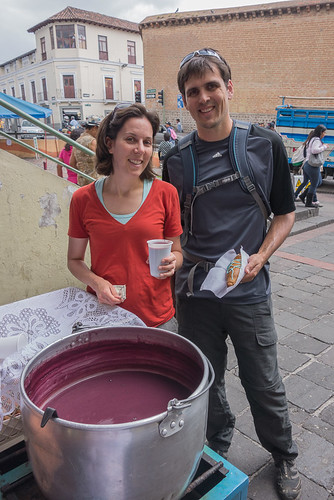
Guaguas de pan and colada morada are often made at home. A few days later, I stumbled upon the grandma of our family owned-guesthouse in Mindo cooking colada morada on the stove. The purple color of the drink was beautiful and the smell of spices and simmering fruit filled the house. Still, some busy urban parents buy it from stores to take home. We saw this sign at a chain bakery in Quito advertising their guaguas (filled with cheese or fruit preserves) and family-size jugs of colada morada.
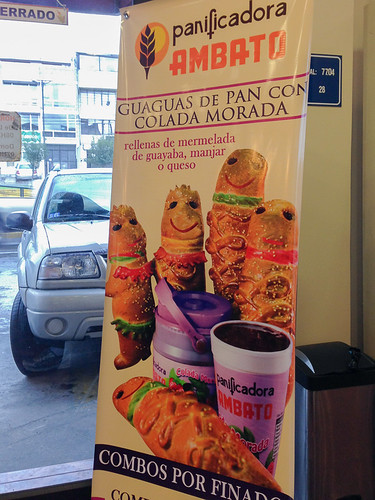
Día de Los Difuntos at the Cemetary
On November 2 we arrived in Otavalo, a city in the Andes with a majority of indigenous, quechua residents. We got stuck in massive traffic getting into the city and arrived there late in the afternoon. I hoped to see lots of indigenous dress and candle-lit handmade altars like I was familiar with in the Mexican “Día de Los Muertos” tradition. As we learned, Día de Los Difuntos in Ecuador is celebrated quite differently.
Rather than going on into the night, most families visit the cemetery during the day. We arrived at dusk to find the crowds leaving the cemetery, not arriving, and street vendors closing down. We spotted this vendor selling more guaguas de pan with colada morada…
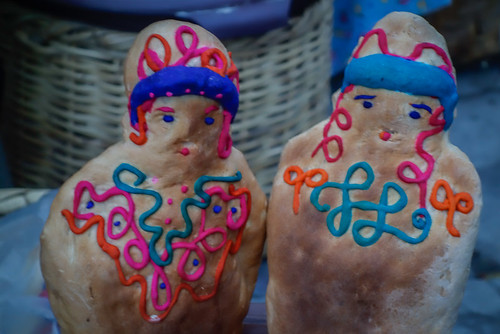
… And this one selling floral arrangements.
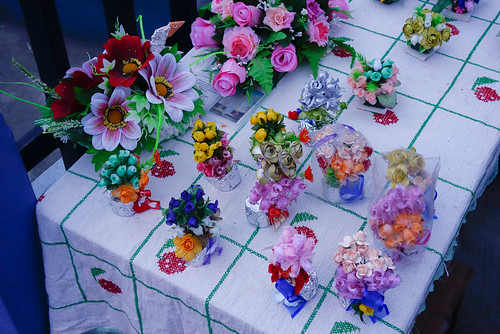
The Otavalo cemetery, like other Latin American cemeteries, is an impressive place. It a whitewashed, walled city with vast white mausoleums and the (more reasonably priced!) vaults stacked six levels high.
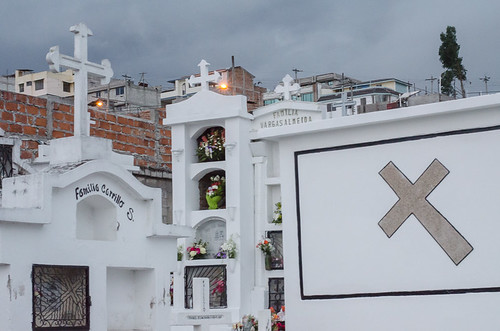
Families gathered beside the tombs of loved ones placing flowers, wreaths, photographs, stuffed animals, toys and other trinkets at the grave site.
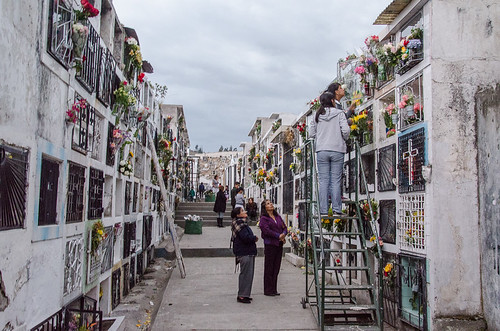
Though the observance wasn’t that different from the American practice of visiting graves and leaving flowers on Memorial Day, the colors and shapes of the large, dense graveyard was a big difference from the green, park-like and (somewhat sterile) graveyards I’m used to back at home.
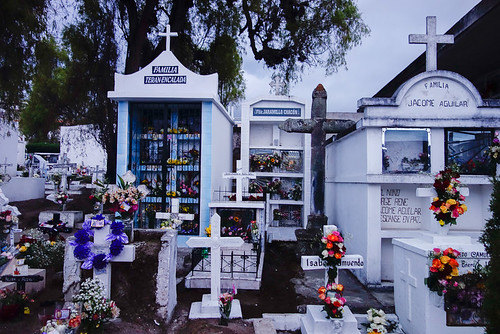
Through the beauty of the internet, I sometimes learn more about a place after leaving it. In writing this, I just learned that there were actually two different cemeteries in Otavalo. We visited the mestizo (mixed/Spanish heritage) cemetery, which is the more subdued and Catholic-influenced practices which explains why it didn’t seem all that different from visiting a cemetery at home. There is also an indigenous cemetery in Otavalo which is a bit more festive and lively where families would camp out all day and eat their meals at the grave site. This was the uniquely Ecuadorian celebration I was actually looking for. Oops!
Still memorializing lost friends and family is an important tradition in Ecuador, and if you visit during the Day of the Dead, join in the celebration and take the time to remember family and friends you’ve lost.
I risked it more often than not and been fine. Most of the time the food is well cooked. I did get owned pretty badly by some mystery meatballs in Cappadocia though. That was rough!
I didn’t know this tradition went beyond Mexico.
Hehe, me too, Shaun! I’ve been *mostly* lucky, but I’ve had a few brief but unpleasant bouts with food or water-borne illness. But it’s part of the adventure, right? 🙂 And I was also surprised they celebrated it that far south.
Correction: Colada morada is not made out of purple corn. We use blue berries -which is grown in the area of the Andes- to give the rich purple color and the tangy taste. Its thickness come from the corn starch, which is only used in a small portion to thick the colada morada. Purple corn is not a commonly used product in Ecuador.
Interesting, thanks for sharing this! The family we stayed with in Mindo used purple corn when they made it, but they did also add the berries. I’ll add that to my description, thanks!
Hi Cassie.
It is good to know you’ve enjoyed your visit to Ecuador.
Just another fact: In Ecuador the languages spoken by many of our indigenous people is Quichua, not Quechua. There is a variation in the use of the vowel i instead of the e that is used and spoken in Peru.
We have a lot of Quichua words mixed and used in Spanish which we call “quichuismos” that enrich our language and sometimes make it difficult for a foreigner to understand what we say.
Regards,
PA